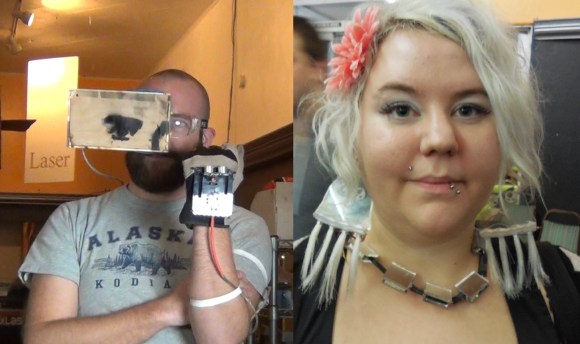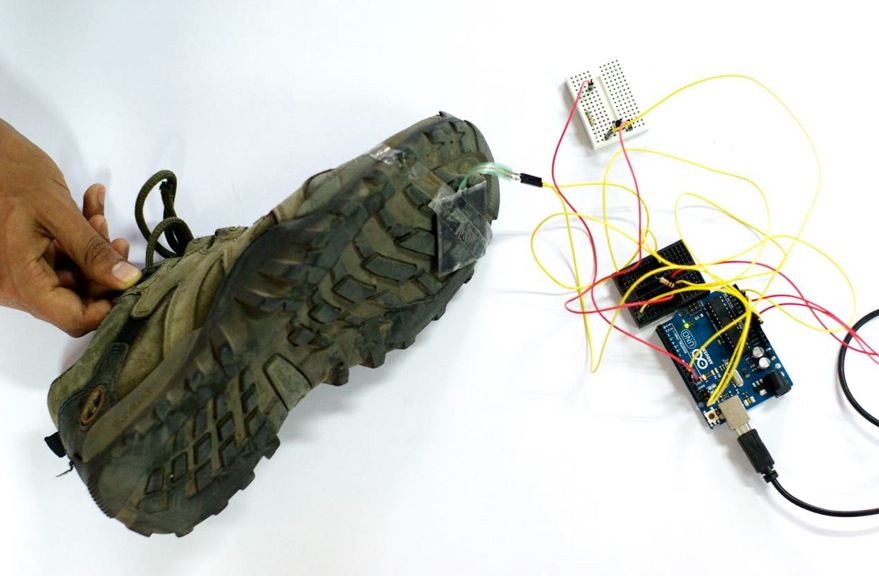25
HackPhx Winter 2014 Hackathon Winners
arduino hacks, bluetooth, earrings, HachPhx, hackathon, Hackerspaces, heatsync labs, iphone hacks, Morse Code, OLED, PING, Virtual Reality, wearable, wearable hacks, wireless hacks, xadow Comments Off on HackPhx Winter 2014 Hackathon Winners
The HackPhx Winter 2014 hackathon was held at Heatsync Labs hackerspace in Mesa, Arizona, USA. The advertised theme was “Arduino Wearables”. Participating attendees were randomly placed on teams evenly distributed by their disclosed skills across all teams. There were 10 teams with 4 to 5 members per team competing for two winning spots.
Each team had to build an amazing wearable project utilizing the secret ingredient which was Seedstudio’s Arduino-compatible Xadow wearable platform and add-ons. The Xadow is similar to the Arduino Leonardo and participants used an Arduino cross compatibility and pin mapping chart to assist in development.
Top prize was the Judges’ prizes for the best completed and documented Xadow wearable team project. The second prize was the Jury’s prize given to the team project that the other teams liked the most regardless of event criteria.
Read more about the winning teams and watch their presentations after the break.
I was already planning on attending the hackathon. When I mentioned this to the Hackaday team they also put me on assignment to film and write about the winning teams. Full disclosure: I couldn’t resist signing up as a team member for some hacking fun.
No team members had experience using the Xadow platform so the playing field was quite level. The range of Xadow add-ons was extensive, but teams could only blindly select from a bucket of donated Xadow add-on modules such as OLED display, LED arrays, motors, accelerometers, GPS, NFC and BLE. Bartering between teams was encouraged as teams developed their final project plans.
The event really began the night before the hackathon with a 4 hour meet and greet to divide into teams and finalize hardware trades. The real event started at 8 am the next morning and lasted for 12 straight hours of mad hacking using any tools and supplies available at Heatsync Labs. Heatsync Labs provided experienced volunteers to assist teams that needed to use lab equipment such as the Laser cutter, 3D printers, welders, metal lathes or any power tools.
All team code, photos and final documentation had to be uploaded to each team’s GitHub repository before judging started at 8 pm.



After the smoke cleared the Judges’ winner was Team 8 with “Morse Code Earrings”. This really was an amazing wearable hack especially if you take into account they scrapped their first project and started over on the winning project halfway through the hackathon. Team 8 utilized the Xadow Bluetooth LE module to send text messages from a phone to a stealth receiving necklace containing an Xadow which modulated the message in Morse code over flashing “Jelly Friend” LED earrings. The earrings were also made by Team 8 using clear acrylic laser cut in the shape of jellyfish and having a base of LEDs and some old Christmas tree fiber-optic lighting parts. The big advantage to having such decorative communication is to send SOS requests to nearby girlfriends when you find yourself entangled in scary company. Or to scream covertly flash profanity at your boss.
Team 8 members:
- Mattie Finney – GossamerLights
- James Brooks – pyrobrooks
- Nate Plamondon – meznak
- Brett Warner – brettwarner



Team 4 with “Over 9000” won the Jury’s prize. This prize winner was picked by all the other teams and I must say my team members were amazing; yes I was on Team 4. My team members were extremely talented at learning this new hardware platform. Almost effortlessly, and with time to spare, they quickly integrated the hardware, code and bits of scrap into a wearable head mounted heads-up Google Glass style interactive and fully functioning augmented reality head unit. I say “they” because I only worked on the glove unit and cabling. The glove unit retrieves distance measurements in feet and inches from a Parallax ultrasonic ping sensor mounted on the back of the glove and is cabled into the back of the head unit.
The project name comes from the accelerometer output mounted in the head unit. Once the accelerometer’s power unit output tops 9000 all the LEDs on the side will turn red indicating max power level activity. This power unit value along with distance measurements to objects in front of the glove unit are internally reflected into the wearer’s right eye from an OLED display mounted at the back of the head unit. If the glove detects objects closer than 3 feet, a front mounted red LED also lights to warn innocent bystanders. The back of the head unit is prewired for jacking in auxiliary off board sensors and equipment to simplify integration and assimilation.
Team 4 members:
- Chad Tech – ChadCS
- Joe Fleming – w33ble
- Doug Sheridan – dsherida
- Todd Harrison – toddfun
Filed under: Arduino Hacks, Hackerspaces, iphone hacks, Virtual Reality, wearable hacks, wireless hacks








